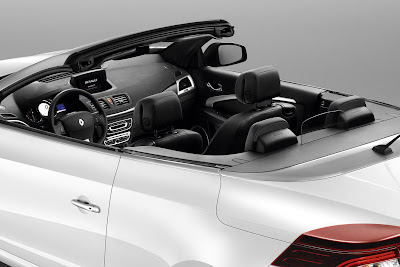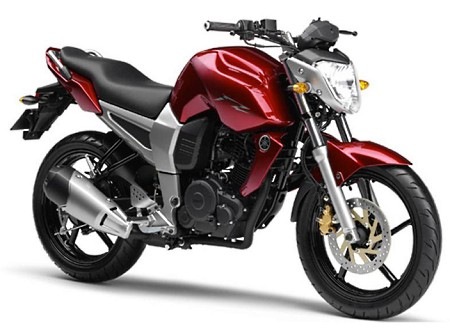
New Mégane Coupé-Cabriolet completes the renewal style of the New Mégane family which is built on the strengths that forged the success of its predecessor. Its new appearance is supported by the large folding glass roof, high-gloss finish, black glass roof contrasts with the satin-effect chrome windscreen frame exterior, and the dark red taillights featuring a linear lighting pattern and LED brake lights to provide a distinctive rear lighting character.
With it’s new style, New Mégane Coupé-Cabriolet goes further by offering customers with unruffled open-top motoring supported by the forward position of the windscreen and a fixed glass, outstanding handling performance with a stiffer chassis and a new electric power steering system, and a broad choice of efficient and eco-friendly powertrains including the all-new automatic EDC (Efficient Dual Clutch) transmission.


The interior of this New Mégane family still presents the same layout with high standard finish of qualified materials available in three choices of trim, which range from dark charcoal and light beige to the charcoal and red two-tone finish with leather seats. Although the dashboard is identical to that of New Mégane Hatchback, the seats offer additional lateral support, while the ‘butterfly wing’ door trim panel is specific to New Mégane Coupé-Cabriolet.

New Mégane Coupé-Cabriolet is available with a choice of seven efficient and eco-friendly petrol and diesel powertrain configurations (depending on the market). The available petrol engines are, the 1.6 16V 110hp engine mated to a six-speed manual gearbox, the TCe 130 (Turbo Control efficiency) driving through a six-speed manual gearbox, and the 2.0 16V 140hp engine available with the new continuously variable transmission (CVT) for even greater driving comfort thanks to smooth, step-less gearshifts. While the diesel engine range, which comprises the Euro5-homologated powerplants are the dCi 110 DPF, mated either to the brand new six-speed EDC (Efficient Dual Clutch) dual-clutch automatic transmission (see below) or to a manual six-speed gearbox, the dCi 130 DPF which drives through a six-speed manual gearbox, and the dCi 160 DPF also with a six-speed manual gearbox.

Public will get their first opportunity to see this New Mégane Coupé-Cabriolet when it is unveiled at the forthcoming Geneva Motor Show (March 4-14). It will also be displayed at L’Atelier Renault on the Champs-Elysées in Paris.

Rounding off the new Megane family is the Coupe-Cabriolet that was formally introduced today ahead of its world premiere at next month's Geneva Salon. Like its predecessor, the new Megane CC is a two door model with an electric folding top that's mostly covered in smoked glass
The French carmaker claims the Megane CC's transparent glazed area of 0.47 sq. metres is the largest in the segment that includes cars like the Pininfarina-styled Ford Focus CC and the Peugeot 308 CC.

The four-seater convertible version of the new Megane also gets a fixed glass wind deflector located behind the back seat headrests that is said to allow draft-free driving at speeds of up to 90km/h or 56mph.


The fully-automatic, electro-hydraulic operated two-piece glass top goes up or down in 21 seconds at the press of a button with the Megane CC's boot capacity standing at 417 litres with the roof closed, and 211 litres when open.
Depending on the market, the new
Megane Coupe-Cabriolet will be available with a choice of up to seven gasoline and diesel powertrains.
The petrol line includes a 110HP 1.6-liter unit linked to a six-speed manual, a 1.4-liter TCe turbo with 130HP matted to a six-speed manual and a 140HP 2.0-liter with a CVT.

Diesel options include the 110HP dCi matted to either a new 6-speed dual clutch automatic transmission or to 6-speed manual gearbox and the 130HP dCi and 160HP dCi that both drive the front wheels through a six-speed manual.
European sales of next generation Megane Coupe-Cabriolet will begin this spring.

 Interior design of megane cabrioet pict images
Interior design of megane cabrioet pict images


 di Silverstone. Il passo di gara è buono e con una partenza azzeccata potrà inserisrsi sicuramente tra i protagonisti del TT olandese. Brutta caduta nelle prove della mattina per il russo Ivanov che si è procurato una lieve distorsione del ginocchio ma che è comunque sceso in pista per le prove di oggi pomeriggio.
di Silverstone. Il passo di gara è buono e con una partenza azzeccata potrà inserisrsi sicuramente tra i protagonisti del TT olandese. Brutta caduta nelle prove della mattina per il russo Ivanov che si è procurato una lieve distorsione del ginocchio ma che è comunque sceso in pista per le prove di oggi pomeriggio. 























































